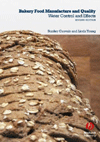Time is on Their Side
by DAN MALOVANY
True artisan bakers know that creating the highest-quality breads simply takes time. Bakery de France automates the art of baking by slowing down its processes.
For most bakers, time is money. For Bakery de France, time makes money. The company believes in the philosophy that a long fermentation process is essential to creating the best-tasting artisan breads, multigrain loaves, rustic rolls and even premium, sliced panned breads.
As the saying goes, you can’t rush a good thing, and those who do are not true practitioners of the art of baking.
“When we say ‘retard’ and we have long fermentation times, we’re serious about it,” says Nadine Salameh, vice president of operations for the Rockville, Md.-based wholesale bakery and part owner of the operation with her husband, John, and chairman Joe Asseily.
“When someone asks you if they are making true artisan breads, ask them how long they take to make them,” she says.
At Bakery de France, there are no shortcuts, especially for its signature country or rustic artisan breads and rolls. In fact, producing par-baked or thaw-and-serve breads often takes up to 18 to 24 hours, depending on the product.
One key to creating full-flavored breads and rolls is an industrial-sized levain system, from which a percentage is added to each batch to accentuate the hearty aroma and the functionality of the bread. The fermented levain process allows Bakery de France to produce artisan breads in the same fashion that small retail bakers would — except on an industrial scale in its 45,000-sq.-ft. plant.
“This system was designed for mass-producing artisan breads,” notes John Salameh, president.
At Bakery de France, two bakers manage the production of this levain, which ferments up to 18 hours. They refresh the mother-sour and track the critical times and temperatures during the extended process.
“It’s not like a San Francisco sourdough, which can have a very vinegar type of taste to it,” Nadine says. “This sourdough has a smooth and subtle flavor to it.”
Throughout its entire process, time is of the essence. Bakery de France may retard doughs for hours or employ longer proof times to enhance the bread’s flavor or provide a distinct texture. Often, intermediate proof times last up to 45 minutes while proof times can range anywhere from one to four hours. Indeed, Bakery de France has been taking the time to do it right for more than 10 years.
Time to Explore
Of course, that hasn’t always been the case. When the Salamehs and Asseily purchased Bakery de France on April Fool’s Day in 1986, the struggling, 2,000-sq.-ft. operation was producing traditional baguettes and other French baked goods for restaurants in the Washington, D.C., metropolitan market.
“When we took over the bakery, there was no long fermentation process for any product,” Nadine recalls. “It was just a straight-dough process from the mixer to the divider.”
As the Salamehs traveled extensively to Europe to research how to produce Old World breads authentically and search for systems to automate their bakery, they visited bakeries throughout France, Germany, Italy and the Netherlands and picked up some good tips from the masters of baking.
“From the beginning, we developed good friendships with some of the most prominent bakers in the world,” Nadine explains. “They started guiding us and telling us about the benefits of the long fermentation process. They said, ‘What you are doing is fine,’ but there was something else out there that was just coming together.”
The fermented levain process provided a sea change in Bakery de France’s portfolio that now includes a diverse basket of dinner rolls, sandwich items and table loaves.
In addition to baking a variety of petit pain, demi baguettes and michette dinner rolls, the bakery now produces focaccia, plain ciabatta, olive ciabatta and sun-dried tomato ciabatta rolls. Its Rustic Collection includes thaw-and-serve Black Forest multigrain loaves, traditional seeded ryes, a Rustic European-style sourdough, a Farmer’s White bread and a honey wheat variety.
In some cases when it came to new products, however, the innovative Bakery de France was simply ahead of its time. A few years ago, for instance, the bakery rolled out fruit and nut artisan loaves. Although they were not popular then, those high-fiber products are becoming increasingly fashionable these days, due to the sophistication of the American consumers’ tastes for such products. In essence, consumers are quickly catching up to what the bakery has to offer, Nadine says. It’s all a matter of timing.
“If we rolled these items out today, they would be a tremendous success with all of the grains and nuts in them,” she notes. “We will slowly reintroduce some of those products.”
Adds John, “We used to sell a lot of baguettes before. We still sell them, but they’re no longer our No. 1 seller. Now, we’re selling more artisan breads.”
During the past year, Bakery de France continued to push the envelope by convincing some of its high-end in-store bakery customers to sell bread by the pound. The product it’s promoting specifically is a large tourte — a 4-lb. loaf of hearty, crusty, country-style bread that is 15-in. in diameter and almost as big as a pillow. The bread is made with a custom mix of flours, retarded for 15 to 18 hours and baked in a three-deck oven at lower temperatures for more than two hours.
“You sell meat by the pound, and you sell cheese by the pound. Why can’t you sell this premium loaf of bread by the pound?” Nadine asks. “That’s what we’ve been trying to convince retailers for the past year. We are trying to romance the product and create a new way of adding value for retailers.”
Time to Expand
Time and time again, Bakery de France has received awards for its new product innovation with consistent double-digit sales growth year after year. Although sales stalled last year as the low-carb craze reached a crescendo, the less-than-$20-million company is looking to expand in a big way by purchasing land to build a 100,000-sq.-ft. plant featuring state-of-the-art equipment for producing authentic European-style breads.
Because of the unpredictability of the market, no firm timeframe has been set for building the new bakery. Five years from now, however, the company expects that it will be a two-plant operation, John says.
“We’ve had some very good growth, and we’re very cautious,” he notes. “Until three or four years ago, we were looking at how to expand at this location, but during the past three years, we began rethinking our strategy, and began purchasing equipment that would be designated for the new plant.”
Even though it has no specific date set for the expansion, that hasn’t prevented Bakery de France from moving forward. In recent months, the company has purchased makeup equipment and stone deck ovens for producing new products and is currently training employees on the systems.
Later this year, the Bakery de France will replace one of its roll lines with a new system that can handle dough with high-water content, such as those used to make ciabatta bread, more easily. The goal is to add production flexibility, versatility, additional capacity and greater efficiencies, John explains.
The bakery operates three shifts, six days a week. One shift on Saturdays provides for thorough sanitation and preventive maintenance. In the past, Bakery de France expanded, taking over one suite and then another in the industrial complex. Today, space is at a premium. Six bread and roll lines are shoehorned into the bakery, which has several mezzanine platforms for storage and other systems. The expansion will allow the company to grow as the market warrants.
For example, the bakery is building a platform for its fermented levain system, which it is expanding from two to four holding tanks to meet future demand for its products. Additionally, relocating the system will allow the plant to better control the flow of levain into the mix.
“In the past, we may have needed to expand, but we didn’t have the space. As a result, we spent a lot of time and energy trying to figure out how to expand in the space we’re in,” John says. “In the new plant, we won’t have to spend too much time figuring out where to put a piece of new equipment. We can focus on how to grow the company.”
To provide front-end controls to the process, all formulation is computerized. Mixer operators simply enter the product, and the formula appears. Because the process is computerized, changes to the formula cannot be made on the production floor.
Flour is fed from a 75,000-lb. indoor silo. The bakery also has bag-dump stations for minor ingredients. On the whole, most ingredients are manually custom-mixed to create the bakery’s distinctive line of products.
Four 500-lb. spiral mixers with 11 removable bowls feed the bread and roll lines with a batch of dough every five to six minutes. Depending on the weather, the bakery uses separate hot- and cold-water meters to control the temperature of the dough.
As a part of its good manufacturing practices (GMPs), mixer operators use industrial handheld thermometers, which allow them to check the dough temperature without touching the dough itself. They simply position the handheld device into the dough, and the temperature digitally appears for them to record. The touchless system minimizes contamination and enhances food safety, Nadine says.
Bakery de France produces its signature breads relying on several unique processes. For instance, the bakery creates ciabatta bread and rolls using a one-of-its-kind makeup system that creates a continuous stream of dough using no sheeters or reduction stations that would de-gas the dough. Rather, the bakery relies mainly on gravity to produce the glacially moving sheet of dough without stressing or damaging the dough.
In the Kosher-certified bakery, producing ciabatta requires a combined fermentation process of more than 18 hours. Once mixed, the high-moisture dough is lifted by elevator buckets and dumped onto a descending, but near-stationary belt inside a temperature- and humidity-controlled chamber. In all, it will take the dough about two hours to travel the 20 ft. to the makeup system below.
At first, the dough looks as though it is barely moving down the belt. However, at the halfway point, the belt doubles back. Canola or olive oil is applied to the belt to provide lubrication for the sticky dough. No oil is incorporated into the dough, which also contains no additives, preservative or softeners. In all, the system produces about 2,000 lbs. of product an hour.
“We really treat the dough with respect,” says John. “We treat it with tender-loving care. We don’t beat it to death with chemicals or machinery.”
After it doubles back, the 15-in.-wide dough stream proceeds to a decline at a steeper rate. Gradually, dough flows onto slightly faster-moving belts, which gently stretch the dough without damaging the cell structure.
Overall, 25 motors synchronize the flow of dough in this unique system, dubbed the “Frankenstein machine” by Nadine, because it was such a monster to start up. In fact, it took nearly two years to get all of the bugs out.
Back on the production floor, the dough flows onto a laminator. As it passes under a reduction station, the side guards shape the dough into sheets. Because the stations are disengaged, no rollers touch, sheet or de-gas the dough.
“We basically create a sheet of dough without using a sheeter,” John adds.
After passing through a tip-topper, which gently kneads the dough once more, the sheet flows through an eight-blade cutter to eight finger conveyors and through a guillotine that cuts the dough into what will eventually be 6-in. ciabatta subs. After being placed on screens and racked, the products are rolled into one of four proofboxes that hold 48 racks and then baked in one of 13 double-rack ovens.
The sub rolls on a spiral cooler for about 30 minutes, then through an ammonia-fueled, cryogenic blast freezer. Upon exiting the freezer’s tunnel, set at -35°F, the products pass through metal detectors and are manually loaded into cases. After being labeled and bar-coded with the production date, time and type of products, pallets are shrink-wrapped, stored in the plant’s holding freezer and rolled into an offsite, cold-storage facility.
For food safety reasons, samples of product from each shift are randomly scored and baked off to ensure product quality.
In addition to a second line that produces focaccia or ciabatta, the bakery also houses a roll line that can produce up to 18,000 pieces an hour. The string line can crank out 2,500-2,700 baguettes, or more than 13,000 mini-baguettes an hour.
Another line with a two-pocket piston divider and cone rounder, produce rustic, country and artisan breads, while a heavy-duty conventional line produces sliced panned breads. The bakery also has an array of slicers, baggers and other systems to package everything from hamburger buns and Kaiser rolls to 24-in. baguettes.
Time for Sweet Goods
To be a one-stop shop, especially for its local customers, Bakery de France produces a variety of pastries and sweet goods, including croissants, filled croissants, scones and muffins, in a sweet shop across from its facility’s parking lot.
The sweet shop houses a semi-automated croissant line — producing croissants made in a traditional manner with pure butter and with the laminated sheet being retarded overnight prior to production. The pieces are automatically rolled, then hand-curled before proofing and baking.
Once a niche operation for a few customers, the semi-automated sweet-goods shop has become an integral part of the Bakery de France business that continues to grow, with six rack ovens now cranking out products.
“Eight years ago, we did 500 muffins a day,” Nadine says. “Now, we’re producing up to 10,000 a day.”
Additionally, the bakery purchases a small amount of product that it distributes to local customers on 20 routes. Although local sales have become a smaller part of its overall operation, John says, the added business provides Bakery de France with critical cash flow to fund its upcoming plant expansion and its growth in the national marketplace.
On an ongoing basis, Bakery de France takes time to evaluate its operation and pinpoint areas where it can streamline production, add capacity or provide more flexibility.
In addition to a new roll line, the bakery is looking to update its croissant line. It’s adding an automatic rail system to its proofboxes so it can better control the time and temperature of its processes. The company also is exploring new mixing systems, new makeup systems, new oven technology and new display cases for distributing its products for both its foodservice and in-store bakery customers.
In the R&D center, next to the sweet shop, bakers continue to work on new products for later this year.
“We have a lot of ideas, but we cannot stop coming up with them,” Nadine says. “When you do, you’re time is up.”
Yet for Bakery de France, time is one thing that has definitely been on its side.
At a Glance
Company: Bakery de France
Location: Rockville, Md.
Plant Size: 45,000 sq. ft.
Products: Par-baked and fully-baked frozen baguettes and other French breads and rolls. Rustic and artisan hearth breads and rolls. Sliced panned breads. Croissants. Baked sweet goods.
No. of Lines: Six bread and roll lines, one croissant line, one muffin line. Assorted baked sweet goods.
No. of Employees: Fewer than 100.
Distribution: 20 local routes. National distribution to foodservice establishments and in-store bakery/delis.
Owners
Chairman: Joe Asseily
President: John Salameh
Vice President of Operations: Nadine Salameh
Investing in Equipment?
Invest in Your People
After Bakery de France invests money in new equipment, it takes the time to train its employees correctly.
“Too often, bakers and baking schools are good at teaching tasks, but they are not good at teaching the process,” says Nadine Salameh, vice president of operations for the Rockville, Md.-based bakery. “Sometimes, it takes six months to a year to learn the process. Our primary focus is that our people take ownership of the equipment. If they take ownership of the equipment, they are going to take care of it correctly.”
To prepare its employees for its eventual move to its new 100,000-sq.-ft. plant, Bakery de France already has purchased some of the equipment that it will install in the new facility. Moreover, it has begun training its employees, even though the move is months, if not more than a year away from taking place.
Some of the equipment, such as stress-free makeup systems, will be used to produce new products that are currently under development. In other cases, Bakery de France’s new oven technology will bring forth a new generation of artisan breads.
“There has to be more time spent on training our employees properly on how to bake these products,” Salameh says. “For example, eventually we’ll be doing more with stone deck ovens. To make our products correctly, going from a rack oven to a deck oven takes training. We like to give our employees six months or more to let them learn the process at their own pace, because we believe in people.”
Keeping Track While Away from the Bakery
With all of the advances in information technology and communications, bakers today can provide real-time assistance with what’s happening on the production floor, no matter where they are.
Currently, Bakery de France can monitor from anywhere its four blast and holding freezers, which are critical control points for the operation. Soon, though, John Salameh, president of the bakery, expects his handheld device will be able to give him e-mail alerts on everything from ingredient handling and mixing to proofing and oven temperatures.
“We’re going to be able to see e-mail alarms if the temperature of the oven is below what it should be,” says Salameh. “Not only are we going to have an alarm, but we’ll get an e-mail alert. It allows us to monitor the bakery better and assist those working in the plant.”
Adds Nadine Salameh, vice president of operations, “It’s all about better communication between management and the floor. There is no longer that gap. We have an open policy here when it comes to management.”

.jpg?height=200&t=1628698413&width=200)




